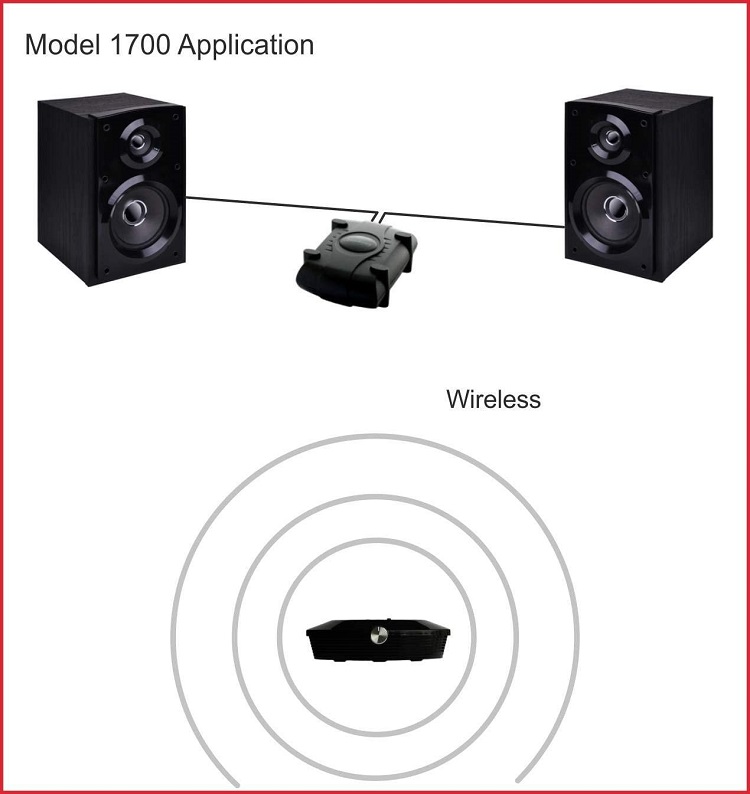Can You Convert Wired Speakers To Wireless?
A wireless speaker conversion kit is a kit that can convert your wired speaker system into a wireless speaker system. So, the answer to our first question is a firm yes – you can convert wired speakers to wireless by using a wireless speaker conversion kit. As such, this simple little device is an indispensable and very valuable home accessory. It puts your home theater system in order. After all, fewer wires equal less trouble. A wireless speaker conversion kit is especially useful if you have an outdoor stereo system. Having an outdoor stereo system often results in wires lying on the ground, which is hazardous, or in wires going through the wall, which is both inconvenient and unattractive. A wireless speaker conversion kit also enables you to connect your speakers to your smartphone and Bluetooth. In other words, this practical device makes your speakers more compatible with the technology.
What Is The Purpose Of Converting Wired To Wireless?
The most obvious reason for converting wired into wireless is to get rid of the countless wires lying around in every 21st-century household. As these many wires and cables, which tend to lie all over the floor, make our homes both hazardous and unattractive, cable management is very important. Of course, using a wireless speaker conversion kit won’t free you of all cables and wires. After all, you will still have to connect the speakers to the transmitters. However, those cables are short and relatively easy to conceal, as are, in most cases, the transmitters themselves.
In addition, people use a wireless conversion kit for a multi-room audio system setups. Numerous transmitters are so powerful that the signal can easily go through walls. This way, you will be able to share audio throughout your home, without having to drill holes into walls or to run endless in-wall cables.
The Top 6 Best Wireless Speaker Conversion Kits
As the most important step in converting your wired speakers into wireless is to choose the best conversion kit, here is our list of the top 6 best wireless speaker conversion kits.
1. Amphony 1800 Wireless Speaker Conversion Kit
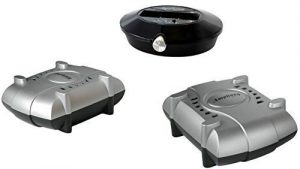
This is probably the best wireless speaker conversion kit currently on the market. It is known for its connection stability, built-in amplification, and multi-room capabilities. The kit features a transmitter and two compact and extremely powerful receivers with a built-in amplifier. The measurements are 5 x 3.5 x 2 inches (12.7 x 8.9 x 5 cm), therefore you can easily mount it and connect it to a speaker. Each receiver can deliver 80 watts of power with the efficiency of a regular class-D amplifier. Moreover, you can even turn it up a bit by connecting all four receivers to the transmitter simultaneously. The audio distortion is very low, virtually unnoticeable. The transmitter’s audio signal reach is up to 300 feet (91.4 meters) directly and 100 feet (30.5 meters) through walls and ceilings. In addition, it has adaptive frequency hopping, skillfully avoiding all the other frequency channels. It has a high power efficiency (rated at 90%, high adaptability) and offers the transmission of uncompressed audio signals.
2. BIC America WTR-Sys Transmitter and Receiver Kit
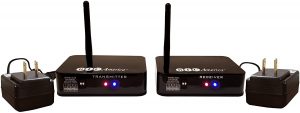
This is a solid low-latency four-channel conversion kit able to support a wide range of devices, including A/V receivers, subwoofers, powered speakers, etc. The kit comes with a receiver and a transmitter, and it doesn’t feature any amplifiers. Therefore, if you are planning to convert regular speakers into a wireless one, you will need an amplifier to amplify and relocate the signal. The obstructed signal range is up to 60 feet (18 meters). The device also includes Velcro strips, which make it more concealable, as well as USB power adapters, USB cables, and RCA to RCA stereo patch cables. Moreover, the kit is very affordable.
3. Amphony 1700 Wireless Speaker Kit
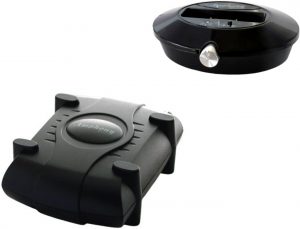
This is a smaller version of the Amphony 1800 Wireless Speaker Kit, however, it is no less competitive. This model is widely praised for having many of the same excellent features as its ‘big brother’ at half the price. It can deliver 2×40 watts of power. As the receiver/amplifier is relatively small (it measures 5 x 3.5 x 2 inches (12.7 x 8.9 x 5 cm)) it is easy to hide. It also features adaptive frequency hopping that avoids interference from other wireless devices and full stereo audio transmission without compression for an exceptional sound. The transmitter can connect up to 4 receivers and its signal range is 300 feet (91.4 meters) directly and 100 feet (30.5 meters) through walls and ceilings.
4. OSD WRSK-250 Wireless Subwoofer & Speaker Kit

This conversion kit features two built-in 25-watt class D amplifiers. It has a compact yet sleek design that enables you to hide the receivers and transmitter. It provides a dedicated subwoofer channel. This system can convert up to a 5.1 speaker system. The wireless protocol is 2.4GHz, however, the fact that it has access to 34 channel frequencies may help with maintaining signal stability and quality. It is not the most powerful device on this list, however, it is very affordable and definitely worth the price.
5. Rocketfish RF-WHTIB Home Theater Speaker Kit
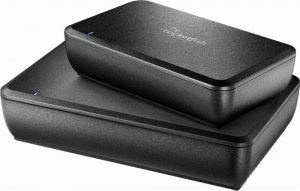
This conversion kit is very simple to set up and it can easily turn virtually any wired speaker into a powerful wireless speaker. Even with 25 watts of power output, this is a very powerful device. It has an elegant and ergonomic design, therefore it can be used in a large variety of positions. It also has a decent signal range (100 feet or 30.5 meters directly). The kit is very user-friendly – you just have to plug in the transmitter and receiver to any audio device. It may not have any extravagant features, but it is affordable and has no connectivity issues.
6. Amphony iFinity – Wireless Speaker Conversion Kit

This is probably one of the simplest, most user-friendly, and definitely the most affordable conversion kit on our list, nonetheless, it’s still a very high-quality device. As it doesn’t have an amplifier, it doesn’t support passive speakers directly, however, if you have an amplifier or a set of powered speakers then it will work perfectly. It offers a wide frequency response range, which makes it great for speakers and subwoofers. The design is sleek and small, therefore it is easy to hide. The transmitter can connect up to 4 receivers, even though the kit only includes two. It has good signal strength, however, you may experience occasional latency.
Related Post
Best Home Theater Speakers
Best In-Wall Home Theater Speakers
Best Outdoor Bluetooth Rock Speakers
Best In-Ceiling Speakers for Surround Sound
How Does A Wireless Conversion Kit Work?
Wireless conversion kits come with a wireless transmitter and receiver setup, sometimes even a built-in amplification, which is needed for converting regular speakers to wireless. As soon as you connect your speakers to a conversion kit, the transmitter sends an audio signal through radio frequencies (RF). Therefore, there is no need for a complex wiring setup. Not only does this setup give us freedom of placement, it also enables us to get rid of all the wires and cables, which represent a tripping hazard and perhaps even a temptation for our pets who love to chew on them.
Before you buy a wireless conversion kit, make sure to check that it’s compatible with your type and number of speakers and audio system.
How To Set Up A Wireless Speaker Kit
The exact process depends mostly on your speaker set up and the conversion kit you decide to use. However, the following is a generalized process description that should work for most scenarios.
- The first step is to choose a wireless speaker kit. There are two main types of wireless speaker kits. One contains a built-in amplifier; the other doesn’t have a built-in amplifier, but only sends an audio signal and requires an additional amplifier to power the speakers. Both are good options, but some tend to opt for a kit without a built-in amplifier, because the power output from the wireless receiving unit is likely pretty low, or at least lower than what your current amplifier outputs. A kit with no built-in amplifier is also a way better option for those of you who have active speakers.
- The second step is to connect the transmitter and thus make your wired speakers work wirelessly. To do so, you have to connect the transmitter to the amplifier or the receiver. The transmitter will send the audio wirelessly using radiofrequency. You can input the audio signal with a speaker wire, RCA, or an Aux 3.5mm input, depending on the kit you choose.
When it comes to speaker wire inputs, you should connect the speaker wire from the outputs to the inputs on the transmitter. RCA inputs are connected from the receiver pre-outs to the transmitter’s RCA inputs. If your transmitter only has a 3.4mm input, you will need a ‘RCA to 3.5mm adapter’, which will enable you to connect the transmitter. Once you have the inputs for the transmitter connected, plug the AC power adapter into the transmitter and the power outlet.
- Now that you have connected the transmitter, it’s time to connect the wireless receiver. This step will actually convert regular speakers into wireless ones. Again, there are various connection options, depending on the kit you choose.
The first and most common option is to use a separate amplifier. In this case, make sure to connect RCAs from the receiving unit to the amplifier, then to connect the speaker wire from the amplifier to the speakers. Also, make sure to plug the AC adapter into a power outlet and connect the other end to the receiver.
The second, less common option is to use a receiving unit with a built-in amplifier. In this case, you can simply connect the speaker wire from the receiving unit to the speakers and then connect power to the receiver.
Then there is a third option – if your speakers contain an internal amplifier. In this case, simply connect RCAs from the receiving unit to the speaker and connect the power adapter for the receiving unit.
- The last step of the process is to test if the system works well – if the signal is strong if the sound is clear if the cables are properly connected and secured if everything works just fine.
How To Convert Wired Speakers To Wireless
The process of converting wired speakers to wireless is possible and relatively simple. All you really need is a wireless speaker conversion kit and some knowledge. Check out the exact process of setting up a wireless speaker kit in the previous chapter (How to set up a wireless speaker kit?).
FAQ
Can I convert old wired speakers to wireless?
Yes, you can convert old wired speakers to wireless by using add-on adapters or a wireless rear speaker kit. Make sure to plug the audio cable into the adapter and then connect it to the adapter using Bluetooth. However, figuring out which wireless audio adapter is right for your speakers may be somewhat complicated and challenging.
How many speakers do I need to convert them into wireless?
The number of speakers is irrelevant. You only have to make sure that the wireless speaker conversion kit you are opting for is compatible with your type and number of speakers and audio system.
Which are better? Wired speakers or wireless speakers?
It depends. If you prioritize practicality and wish to set up a system as quickly and painlessly as possible and if the sound quality isn’t your main concern, then wireless speakers may be the best option for you. On the other hand, if you want to maximize the sound quality and perhaps expand your system with audiophile hardware, you should choose wired speakers. It also depends on the location. For an outdoor setup, it’s definitely way more convenient to choose wireless speakers, simply because they are much easier to set up, they don’t require cable management, and they are not as affected by bad weather.

